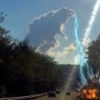
A Night At Tumacacori National Historical Park
#1

Posted 20 July 2014 - 12:10 AM
First, a little background. The territory in this part of the world was occupied primarily by a culture called the O'odham ("The People"), comprised of several subcultures including the Tohono O'odham, or Desert People. The early Spanish conquistadors called them the Papago, loosly translated as Bean Eaters after a white bean that was a staple of their diet. The tribe itself took this as an insult, and always called themselves the Tohono, and this name was officially adopted by the US Department of Indian Affairs in the late 1960s.
In the late 1600s, Jesuit priest and astronomer Father Eusebio Kino traveled the Southwest and established over 20 missions among the O'odham Indians that he encountered. Meeting the O'odham in Tumacacori, he established one of his missions that is now part of the Tumacacori National Historical Park.
One activity that is practiced by TNHP is periodic weekend camping events inside the mission grounds, where cultural awareness is exchanged with the invitees. Several weeks ago, John Dwyer, the President of the Sonora Astronomical Society, was asked to help at one of these events to roll the clock back to the late 1800s and what use would be made of the sky in that era. John contacted me, since he knew of my interest in cultural astronomy, and we decided to split up the task between the perspective of the migrating cowboy populations and the other travelers and permanent residents of the area at that time. Unfortunately, John became quite ill for a time, so I was happy to cover the topic.
When I arrived, I met with Melanie Rawlins, the National Park Service Ranger in charge of the event. There were several interpretive activities for the camping session; an art lesson for the attendees in sketching the mission grounds and converting the sketches to charcoal drawings for permanent saving, the exposure to the use of the night sky in the late 19th century, a session of story telling around a campfire, western song singing, and other cultural exchanges before the night ended with camping inside the mission or on the grounds.
There were supposed to be 30 guests of the Park, but a group of 15 Girl Scouts dropped out because of concerns for the ongoing monsoon rain potential. So, the remaining fifteen hearty souls got their introductory history lesson, then came the art instruction that was extremely well presented. Then it was my turn.
I introduced my talk the way I've been taught by my Interpretive Ranger guide, Marker Marshall at the Grand Canyon National Park. I told them I wanted them to take home a piece of the Park - the serenity of the night sky and it's celebration of the night, and to recall the night sky when their own use of light was considered. Not for the astronomical benefit of reducing light intrusion, but from the cultural point of view, as well as the environmental impact on the night life, the reduction of the greenhouse gasses to produce the light, and the excess cost for un-needed capacity that costs us all. Then the sky talk.
It was a bit difficult to, as Hawaiians would call it, "talk story" about the sky when there was cloud and lightning around, so I steered the discussion to WHY do cultures feel called to the sky? I compared the European way of life as shown in the henges, especially Stonehenge but over 1000 other similar constructions that have mostly disappeared over the ages because they were made of wood, but the geological evidence remains, contrasted with the Native American seeking of balance with nature. Then I went into the O'odham creation story, and how the Sun was to give light in the day, Moon to give light at night, and stars to give direction to find one's way. For the cowboy travelers, I used the Big Dipper clock and how the hours at night could be marked, but locals could also use Kochab and seasonal variations with the rising and setting of Alkaid, Arcturus, and Spica in the west and Capella and the stars of Casseopeia in the east, with Corona Borealis thrown in. Kochab combined with the bright star positions gave year round travelling and time passage guides to the local residents.
The time era in discussion was also a time of Apache incursion into the area, so I noted how July is a special month for both O'odham and Apache cultures. For the O'odham, July is the beginning of their year, while for the Apache, it is extremely important as the month of the Puberty Ceremonial, a four day/night ceremony celebrating the passing of young girls into womanhood, and their role as life givers to the Apache. And the passage of the stars is extremely important to both cultures at this time, because for the Apache the singer of the ceremonial had to hit certain songs at key locations in the sky such that, on the fourth morning, the end song could be sung by the entire tribe in the moments before sunrise to bring the sun alive to bless the young women with productive, long and healthy lives. Miss the key times by a minute or so, and it was a bad ceremony and could mean less than ideal lives for the future of the young girls. Missing the orientation of the sky for the O'odham could mean misdirection in the desert and not finding the key vegetation and water for survival.
I left them with the challenge to be a little introspective and ponder why the night sky called to them? They had watches, and calendars, and still they looked up through the holes in the rain clouds with wonder. Why? It was each of their own motivations to consider, with no right answer.
The great experiences had by all the participants is due to the enthusiasm and efforts of Melanie Rawlins, the NPS Ranger in charge of the event. It was a joy to work with her to bring the history alive for the visitors. The NPS Rangers are truly special people, committed to their calling, and quite an inspiration to be around.
A nice little article about the weekend was written in the latest Nogales International. Please take a look if you have a chance, and if you live in, or visit, Arizona please look in on this wonderful little museum and mission, about forty miles south of Tucson and 20 miles north of Nogales on Interstate 19, for a look back at a different time, that is really timeless.
Tumacacori National Historical Park
Nogales International Article
#2

Posted 20 July 2014 - 10:22 AM
#3

Posted 20 July 2014 - 11:00 AM
#4

Posted 09 August 2014 - 10:20 AM
Look up, the view is better then looking at your feet..........
#5

Posted 09 August 2014 - 11:42 AM
There will be another sleep over on September 6 at Tumacacori National Historical Park. I hope we have some sky this time to do the historical use of the night sky in the region. Many cultures lived and traveled through the area in the 1800s, from Tohono O'odham, Akimel O'odham, White Mountain and Chiricahua Apache, cowboy cattle drives, and the beginnings of the artist colony at Tubac.
The sleep overs are rich in cultural learning for the 30 lucky folks who get to be part of the event. For $20 they'll have demonstrators preparing traditional vaquero hot dinners and breakfasts, artist interpreters who will show the guests methods of capturing the scene now with the mission and the museum for themselves, we'll do some historical astronomical interpretations (Fr. Kino, who established over two dozen missions in the southwest before his death in 1711, was also an avid astronomer), guided museum interpretations, and ghost stories around a fire pit. I've been studying some Tohono ghost stories for the fire pit. Cowboy poet(s) will also be leading a sing along of traditional trail drive songs.
http://www.nps.gov/t...y-sleepover.htm
#6

Posted 10 August 2014 - 11:36 AM
Jim, I just had a chance to read this. What a wonderful way to share the night sky and how other cultures watched it, and used it as a means of keeping time for important aspects of their lives. You do a wonderful job with these, and you are always an inspiration for what feels like my own meager efforts by comparison.
Keep up the great work; those that hear you are better from the experience.
#7

Posted 10 August 2014 - 03:43 PM
magic, we both open aspects of the universe for our audiences, each of us in ways that call to us; yours are certainly not meager, and are an inspiration for me to up my game. Up until a few years ago, I'd do the story telling for the lines waiting at either my 10" or 18" scopes at public or private outreach events. Then I branched out, doing both live video, as well as the multi-cultural seasonal tours at dusk as I learned more about folks other than the Greeks. However, doing the cultural exposure has taken away the raw scope time, and I kind of miss that, especially at the Grand Canyon Star Party. Having to run the night theater indoors while the dusk is setting in, then doing one or more of the constellation tours, means my grandkids and wife are getting all the scope fun. It is really worth it, though, to hear the commentary that what the 30 minute sky walk provided was life altering and to see some of the volunteer astronomers as well as Interpretive Rangers sneaking into the crowd.
The Tumacacori experience is quite different, strictly local culture. In a period of about 450 years, at least seven cultures occupied the region and each brought their own sky lore (local Native American, Navajo, Tohono O'odham, Akimel O'odham, Chiricahua Apache, Mescalero Apache, White Mountain Apache), Spanish initial forays with European/Christian world views, the cowboy/vaquero cultures, and Eastern travelers leading to the artist colony in Tubac, all with their own points of view from constellation stories to creation myths to special ceremonials in addition to the usual interpretation of star configurations. Very big differences among the cultures, with the Navajo and Apache being highly spiritual compared to the O'odham (called the Papago and Pima by the Spanish), who do not attribute mystical powers to astral elements. The others are more like the Cherokee, Seminole, and Plains tribes with supernatural laws and powers. Relaying the why and how the cultures made use of the gifts of the night sky in so many unique ways really makes the mission and museum grounds come alive, and, frankly, doing it at night with only small lanterns and a fire pit adds its own mystic time travel. You just don't get that spiritual, ceremonial point of view in a cowboy movie!
I hope you can visit out west and bring your gifts; nothing like 7000 foot inkwell skies.

















